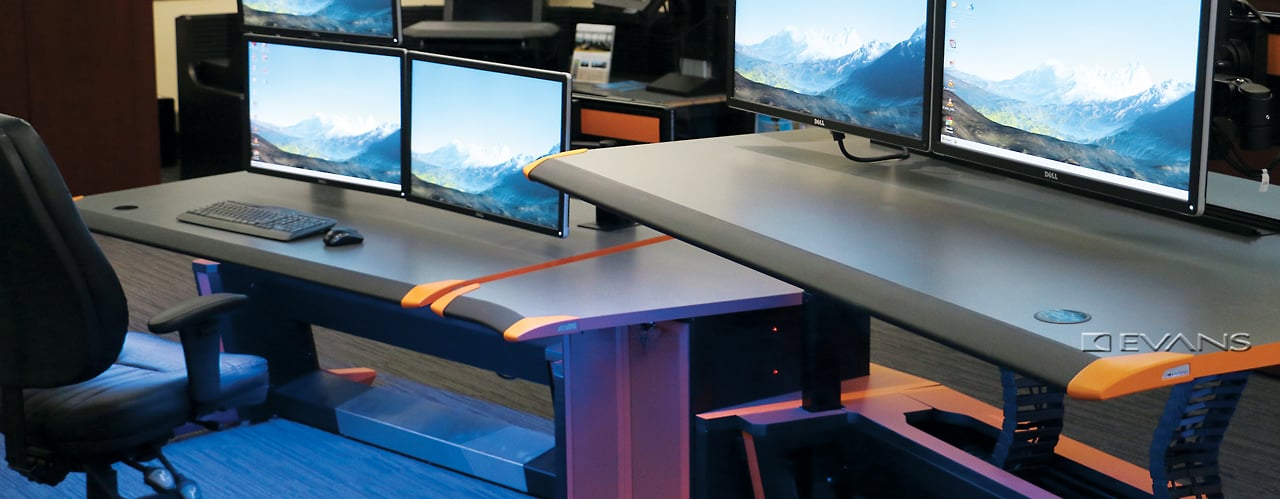- Blog
- Control Rooms (26)
- Events (21)
- Public Safety (21)
- Team (19)
- Ergonomics (9)
- Product (8)
- Mission-Critical (7)
- Console Cleaning (5)
- Air Traffic Control Towers (4)
- Acoustics (3)
- Denise Amber Lee Foundation (2)
- Government (2)
- NASA (2)
- GSOC (1)
- Oil & Gas Control Rooms (1)
- Project of the Month (1)
- Virtual Reality (1)
- Warranty (1)
Congratulations on your Strategy Air Sit-Stand Console! Welcome to the beautiful world of ergonomics, a.k.a. The world with too much information. Change is always hard, especially in dispatch communication centers; you’re used to your keyboard, mouse, console, and tchotchkes the way you like it. I get it! Take a deep breath and enjoy this tour through your new height adjustable console, as we have done the work for you. Here is an easy step-by-step guide on how to use a sit-stand desk to get the most out of it.
1. Transition from Sit to Stand
A common mistake people make is standing for long periods immediately. Just like starting anything new, it takes time. Set your timer, alarm, or Go-Go Gadget watches and begin with 10 minutes every hour, while increasing gradually. It’s generally recommended not to sit for more than 50 minutes at a time, where possible.
2. Mix It Up and Change Positions
Listen to your body and change positions when needed. If your shoulders and neck start feeling stiff, stand up. If your feet or legs start to feel tired, take a seat. As humans, we need variety! Think about adding in squats, lunges, or leg-lifts to get some additional movement.
3. Aim for Correct Posture
Whether you are sitting or standing, maintaining a neutral body position is critical; hunching over, twisting, or looking up at your screens can cause long-term issues and discomfort in any of these positions.
Here’s a quick guide for proper positioning in both a sit and stand orientation:
- Wrists should be neutral - relax and roll your shoulders back. Make sure your elbows are at a 90-degree angle (so keyboards and mice are easily reached in this position).
- Head is level or bent 15-25 degrees. Generally speaking, the head is in-line with the torso. (i.e., when viewing the monitor, the monitor is at eye level or slightly below eye level).
- Sit up straight!
- Avoid twisting, bending to the side, bending forward or slouching of the torso.
4. Shake It Out and Keep Moving
Keep loose while you are sitting or standing by working out some kinks! Try doing some shoulder and neck rolls, reaching above your head, and quad stretches while you are standing. These exercises are great to relieve tension and stress!
5. Standing Support – Think About Your Feet!
Standing for long periods can also be as detrimental as sitting for too long. As you're transitioning into your sit/stand environment, make sure to have additional support under your feet; even if the surface is carpet, this often is not enough. Opt for a cushioned mat to stand on and comfortable shoes (sorry ladies, heels are out!).
Start Small & Change Your Routine Slowly
Just as I stated in the beginning, change is hard. Making small adjustments in your day-to-day routine can have lasting impacts. It’s a New Year! Give that height adjustable console a try and remember, listen to your body; our mind tries to trick us, but if you let your body do the talking, you’ll be glad you did! Start messing with those arrows and get to standing! (or squatting, or lunging, or dancing…)
If you would like to learn more about how we are changing the way we think about control rooms, download and read the following whitepaper.
Topics: Public Safety
Subscribe for monthly updates:
Subscribe to our blog today for expert tips, news, and insights on the control room industry.
 How to Make the Most Out of Your Height Adjustable Console
How to Make the Most Out of Your Height Adjustable Console